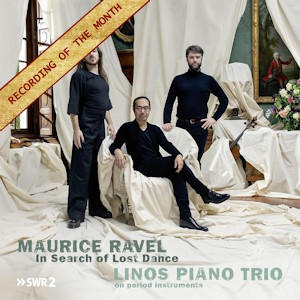
Maurice Ravel (1875-1937)
In Search of Lost Dance
Trio for violin, ‘cello and piano in A minor, M.67 (1914)
Pavane pour une infante défunte (1899, arr. Linos Piano Trio)
Le Tombeau de Couperin, M.68 (1914-17, arr. Linos Piano Trio)
Linos Piano Trio
rec. 2022, SWR Baden-Baden, Germany
CAvi-Music 8553526 [58]
The Linos Trio is international if nothing else; a London-born German-Brazilian violinist; a French-born cellist based in Berlin; and a Thai-British pianist! Of course there is a lot more to them than that. They take their name from the mythological composer and lutenist, and devote themselves to ‘pursuing the boundaries of the genre’, i.e. that of the piano trio.
So how have they gone about that here? The major work on this disc is Ravel’s wonderful Piano Trio, which is one of his major achievements in the field of chamber music. He was in the middle of writing it when World War 1 broke out; he spent five weeks completing the Trio, then signed up for service, and for the first year or two of the war drove an army ambulance – even though his greatest dream had been to be a pilot!
The Linos have approached the work from a ‘period instrument’ perspective; that can seem a bit uncomfortable to those of us of an age for whom Ravel was very much a composer of the recent past! But they have considered primarily the nature of the instruments they have used; the piano for this recording is an 1882 Érard, close in the delicacy of its sound to the one Ravel played on at home, and used in the composition process. The string players have simply used gut strings on their instruments; the result is the most perfect balance between the three parts. It is a continual source of distress to chamber musicians that the colossal power of Steinway or Bösendorfer pianos, with their overwhelming resonance, can lead to a constant battle to be properly heard, and therefore must often detract from the subtle nuances of tone that strings are capable of.
The Piano Trio, then, receives an ideal performance; there are moments in the first movement when Ravel lands on a subtly unexpected piano chord, and the strings breathe gently around it – the beauty and mystery of it took my breath away. Let it be said that the recording allows all this to be heard perfectly. The scherzo-like Pantoum again benefits from the comparative lightness of the piano sound, and the contributions of the string players here are beautifully pointed. This is incredibly hard music to play from the technical angle, yet it sounds effortless, full of colour and imagination. The deeply-felt Passacaille begins with the subject played in the bass notes of the piano, and again, the finer and less resonant tone allows a clear presentation of that theme. The deeply expressive string phrases are able to blossom with painful ecstasy – this is Ravel at his greatest.
The finale, with its veiled backward glances at the first movement, is given a powerful reading. Despite the tone quality of the Érard piano, Prach Boondiskulchok (great name!) is able to get plenty of muscle into those big piano chords.
Unsurprisingly there are dozens of fine recordings of the trio available. I have always admired the Florestan Trio’s reading, with Susan Tomes outstanding at the piano (Hyperion 67114), and the Decca issue, with its star line-up of Joshua Bell, Jean-Yves Thibaudet and Steven Isserlis, has some stunning playing(Decca 4258602). There have been some notable recent versions too, by the Neave Trio on Chandos (CHAN20167), and the Sitkovetsky Trio on Bis (BIS2219), equally impressive if somewhat too extrovert at times. But at the moment I cannot see past this Linos reading – it is simply superb, certainly one of the very finest around today.
The remaining tracks after the Trio are taken up with two of Ravel’s best-known works in special arrangements by the Linos themselves, namely the Pavane pour une infante défunte and Le tombeau de Couperin. Do these work? Emphatically yes. The Pavane receives an entrancing performance, and has been arranged with the greatest sensitivity. Nothing too elaborate, so that essential poignancy of the piece is fully present; but there are telling touches of piano ripples, pizzicato and harmonics from the strings, all of which enhance the overall effect. Some may find the portamenti of violinist Konrad Elias-Trostmann excessive; I do not, because they are completely in keeping with the notion of responding to this music in its historical context, and we know that in the 19th and early 20th century, string players customarily used far more portamento (i.e. expressive shifts of hand position) than players mostly do today. But it has to be achieved with taste, and that is exactly what Elias-Trostmann has done. One final touch, very near the end, is the use of senza vibrato – playing with no vibrato – which adds a certain je ne sais quoi (pardon my French) to the concluding bars.
Ravel dedicated all the movements of Le Tombeau de Couperin to friends who died in action during World War 1. There are six movements in all (of which just four appear in the well-known orchestral suite). We begin with the lively, restless Prélude, and end with the brilliant Toccata. The movements in between feature a Fugue (surely Ravel’s only fully-fledged use of the form!) and three dances that could be found in 18th century suites, Forlane, Rigaudon and Menuet. The Linos again demonstrate their musicality, shaping and characterising the music beguilingly. I can’t remember hearing anything in a long, long while more beautiful than their Menuet.
What an issue! Every aspect has been prepared with musicianship, erudition and love.
Gwyn Parry-Jones
Help us financially by purchasing from





















